- News
- Reviews
- Bikes
- Components
- Bar tape & grips
- Bottom brackets
- Brake & gear cables
- Brake & STI levers
- Brake pads & spares
- Brakes
- Cassettes & freewheels
- Chains
- Chainsets & chainrings
- Derailleurs - front
- Derailleurs - rear
- Forks
- Gear levers & shifters
- Groupsets
- Handlebars & extensions
- Headsets
- Hubs
- Inner tubes
- Pedals
- Quick releases & skewers
- Saddles
- Seatposts
- Stems
- Wheels
- Tyres
- Tubeless valves
- Accessories
- Accessories - misc
- Computer mounts
- Bags
- Bar ends
- Bike bags & cases
- Bottle cages
- Bottles
- Cameras
- Car racks
- Child seats
- Computers
- Glasses
- GPS units
- Helmets
- Lights - front
- Lights - rear
- Lights - sets
- Locks
- Mirrors
- Mudguards
- Racks
- Pumps & CO2 inflators
- Puncture kits
- Reflectives
- Smart watches
- Stands and racks
- Trailers
- Clothing
- Health, fitness and nutrition
- Tools and workshop
- Miscellaneous
- Buyers Guides
- Features
- Forum
- Recommends
- Podcast
feature
Heat and Dust: We follow Paris-Roubaix with Team Sky and IG Markets (+ pictures)
In springtime, most Sunday afternoons would see me glued to the TV screen watching the drama of that weekend’s Classic unfold. Last Sunday, however, found me dipping in and out of Paris-Roubaix thanks to Team Sky and its sponsor, IG Markets, while acquiring an unexpected knowledge of the autoroute network of Northern France; it was a thrilling and unforgettable experience and also, as will be seen, an unexpectedly emotional one.
On Saturday evening in Compiègne, IG Markets had unveiled its new IG Cycling Index to the press at a dinner where guests included French legend Laurent Jalabert as well as Team Sky supreme Dave Brailsford and directeur sportive Servais Knaven, who last year rode the race for the sixteenth and final time, finishing all of them, and winning in 2001.
The following morning saw us up and about early to be assigned our vehicles, the mix reflecting the broad-based and international interest in the race. Besides specialist cycling journalists, we had writers from daily newspapers in Britain and abroad.
One, the editor of a respected paper in his home country, had broken off from a holiday in Europe to fill in for a colleague. There was even a former Olympian, now sports journalist, in our midst. Such is the draw of Paris-Roubaix.
Lesson number one of the day was the extent to which a big bike race can disrupt the normal traffic flow around a small French town, particularly one with a medieval street plan at its core; some 20 minutes after setting off on a tour of the outskirts of Compiègne, we arrived at the village depart. At most, it would have been a ten-minute walk from the hotel.
After an hour or so wandering round, checking out the bikes that had been prepared for 258km journey north – more of that in a tech-focused piece later – and watching the signing on followed by the riders rolling out of the huge square in front of Compiègne’s chateau, it was back to the vehicles and off we went.
Immediately, we encountered one of the conundrums of old-school, on-the-road cycling journalism; it’s fantastic for access to teams, riders, suppliers and race organisers, but you don’t actually get to see much bike racing.
Race radio is one way to follow events until you get to the press centre near the finish, but we didn’t have that luxury. Eurosport’s live text coverage was pressed into service through the iPhone, leading to excitement when we learnt that Wiggo had gone off the front in a small break, disappointment when we heard he’d been brought back.
Just before Cambrai, around 100km up the autoroute, we turned off and soon reached the start of the second stretch of pavé – designated Secteur 26 in the countdown format employed by organisers – comprising 1.8km from Viesly to Quilévy.
The number of the secteur, like the other 26, was announced by a banner across the road, next to a tiny chapel, striking in its brick and stone simplicity. A couple of policemen and a few locals milled around, while a member of Liquigas team staff sat on a bench, smoking a cigarette, and said he reckoned Peter Sagan might have a good race today.

Those of us on the Team Sky party, however, had great hopes for Geraint Thomas, black and blue caps donned as much to show solidarity with the cause as to keep the blazing sun out of our eyes. Seeing the clouds kicked up by the odd car or motorbike roaring up the pavé well ahead of the race suggested they might be useful for keeping the dust out of our hair, too.
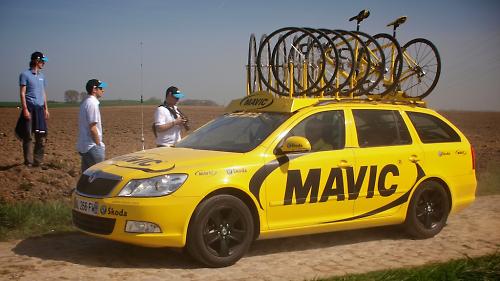
This part of France was of course ravaged during the Great War; the nickname The Hell of the North comes not from the undoubted toughness of the first two decades of the race, but the devastated landscape that greeted it when it resumed following the Armistice.
But relaxing in the warm sun amid green, peaceful countryside, the image that sprang to mind was one from two decades later and across the English Channel in 1939 as Londoners taking a break from the capital’s grime picked hops in the fields of Kent, as they did every September.
For them, it was the odd plane overhead that served as a reminder that Britain was at war with Germany. For us, passing cars speeding VIPs, media and officials northwards, told us that the tranquillity was about to be shattered, the race’s imminence heralded by the rising sound of the approaching helicopter.
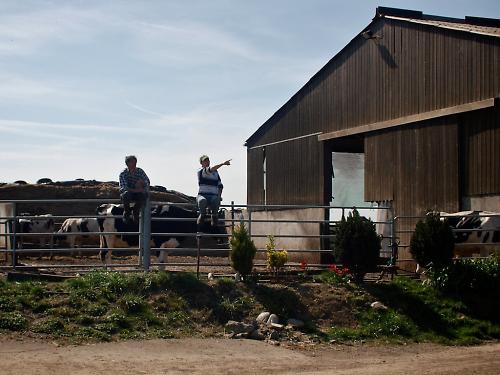
All of a sudden, it was here, preceded by the usual cavalcade of cars and motorbikes, then a small break desperately trying to gain enough of an advantage to keep clear. One member, Rabobank’s Marteen Tjallingi, would finish third, and by the time they hit the Arenberg, the group would comprise 11 members and have a two-minute advantage.
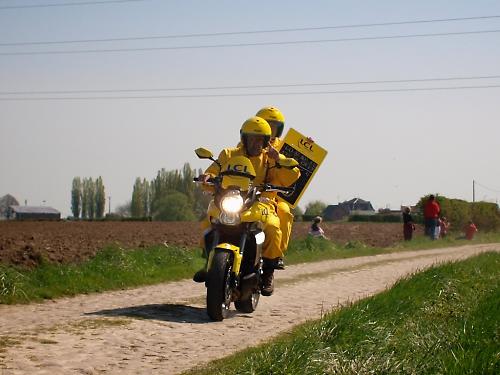
Less than a minute later, the main peloton swept by, Quickstep’s co-leader’s Sylvain Chavanel and Tom Boonen to the fore, unaware of the drama ahead that would send both crashing to the ground and put the Belgian out of the race.
Garmin-Cervelo’s Heinrich Haussler was there, too. Four hours later, face caked in dust, accentuated by the white frames of his sunglasses, he’d ride into the Velodrome in Roubaix, his expression that of a man who had visited Hell and survived, but only just.

A cloud of dust marked the peloton’s passing – a momentary discomfort for us spectators, but an added hazard for those cycling in the thick of it – and riders who had been dropped tried desperately to rejoin the bunch and keep their race alive, the narrowness of the road and rules governing the presence of team cars meaning there was little hope here of a sticky bottle.

Our next stop was the Arenberg Trench, as mythical a place to the cycling heritage of Northern France as Mont Ventoux is to the South. While the unseasonal heat may have been more reminiscent of Provence than Flanders, the surrounding forest and cinder covered embankment either side of the disused railway bridge serving local mines meant it remained as forbidding as ever.
That’s without even considering the cobbles. The contrast of the latter with those we’d seen earlier at Secteur 26 made it clear why the Arenberg is officially ranked by organisers as one of the most difficult secteurs with a five-star rating.

Before seeing the fabled, 2.5km stretch of pavé , however, we first had a lengthy trek to make through the trees from the car park. We’d worked out that the race was running well ahead of schedule. The familiar sound of TV helicopters told us it might be even further ahead than we thought. A brisk walk turned into a jog. As the first helicopter came into view, that turned into a full-pelt run.
Our fears proved unfounded. The race hadn’t arrived yet, the aerial shots presumably showing TV viewers the crowds thronging either side of Paris-Roubaix’s emblematic feature. Vantage points were quickly secured, but the best - barring the out-of-bounds bridge - had long gone, claimed by groups of fans who had clearly arrived hours earlier with well-stocked cool bags.

With the border just a few miles away, the Belgians were here in force, but it was a small band of well-fuelled Norwegians who were making the noise. With a big screen installed close to the entry to the secteur, for many fans the Arenberg was the only place to be.
Even to hardened Paris-Roubaix watchers, the pace of the peloton as it swept along the 2.5km cobbled road that slashed through the lines of the trees was breathtaking. The break we had seen earlier had seemed destined to fail, but now looked much more dangerous with a lead of nearly two minutes.
Rabobank’s Lars Boom led the chase as the main group thundered past, strung out like a seemingly endless express train that risked shedding its rearmost carriages.
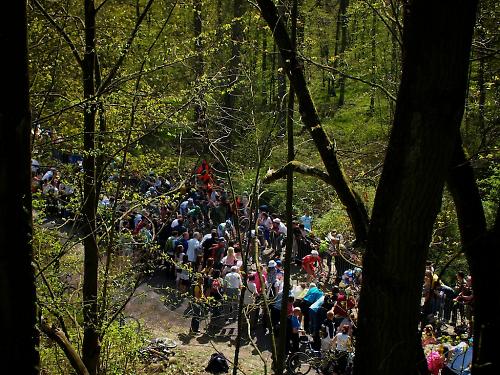
Those of us not lucky enough to be close to the big screen remained unaware of the drama unfolding all around; Roger Hammond breaking his collarbone shortly before the Arenberg, Tom Boonen waiting for what to him must have felt like an eternity for his team car to arrive with his spare bike – news of these, and other individual calamities, would only drip through later.
We had no time to stop and try and catch up with what was going on – we had our own race to run to get to Roubaix and into the velodrome before the riders did. In the end, we made it with time to spare.
On a couple of occasions, traffic jams threatened to hold us up but quickly cleared. At one point, as the autoroute passed alongside one of the remaining pavé secteurs, departing fans told us the race had already been through. We could be cutting it fine though Fred, our driver, a local lad, seemed unworried. That could have been down to his lack of English, of course.
But suddenly, we were heading past Lille and into Roubaix and then, for the first and only time of the afternoon, found ourselves on the actual route, ahead of the race, on to the final cobbled secteur and under the flamme rouge before the entry to the Velodrome, the streets already starting to fill with expectant fans and locals, some smiling and waving as we sped by.
Parking up close to the concrete hulk of the new, covered velodrome currently taking shape in Roubaix, we made our way into its famous neighbour, already filled with fans watching the drama unfolding on the big screen.
Here, finally, we could relax and catch the final 20km of the race. The crowd was initially gripped by the battle between Cancellara and Hushovd and their chase of the leading riders. But as the kilometres ticked down, something changed as Johan van Summeren went off the front on his own.
Slowly, it dawned that the desperately chasing Cancellara wasn’t going to catch him and the unheralded Garmin-Cervélo rider was about to pull off a shock win.
Massed ranks of photographers had positioned themselves to capture the leader’s entry to the Velodrome. But as the 30-year-old Belgian entered the final kilometre to seal what was, by now, an almost certain victory, their attention was attracted by one of the more unexpected events of an extraordinary day.
A commotion erupted within the throng of people on the inside of the track close to the entrance to the stadium, at its centre a woman who, it quickly became apparent, was the cyclist’s girlfriend; moments after their reunion at the end of the bend following the finishing straight and Van Summeren’s surprise proposal, she would be his fiancée.

Afterwards, several of us agreed that the Belgian’s surprise win, and especially the manner in which he had held on – again, it would only later emerge that he’d ridden the last few kilometres on a slow puncture – had brought a lump to the throat. Had we known about his impending proposal, we may have been reaching for the tissues as he rode for the line.

The race had been won, but there were still countless individual stories being concluded before us. One of those involved Tjallingi, who after a long day out in the leading group had held on behind Cancellara to outsprint Gregory Rast of RadioShack and take third, celebrating as though he’d won.

Meanwhile, the 12-man sprint for seventh place would be played out while the future Mr and Mrs Van Summeren raced towards their celebratory embrace. And with each rider that arrived, as they clambered off their bike on the inside of the track, team staff, loved ones, wellwishers and media would head towards them to discover each personal story.
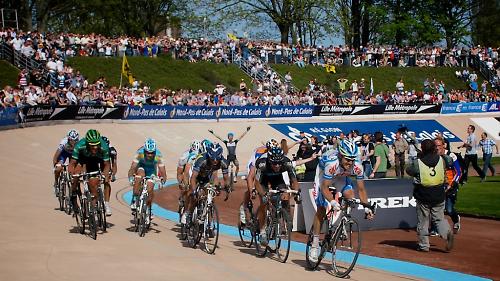
And still it continued. Europcar’s young French rider Damien Gaudin, exhausted after clinching 16th place, collapsed on the grass, quickly surrounded by photographers before team staff or medics could reach him. Meanwhile, the body language and stained national champion’s jersey of Geraint Thomas, caught up in a series of crashes, said all that was needed about his day.
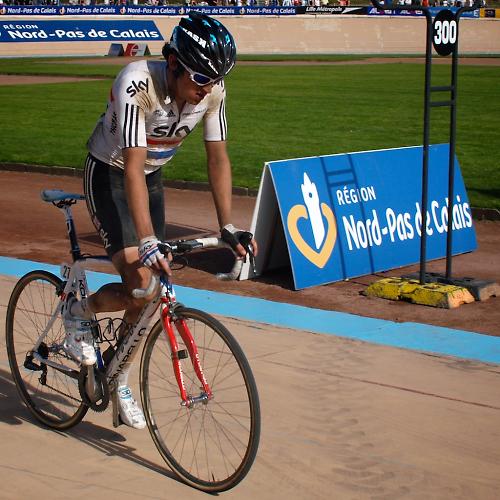
With Juan Antonio Flecha ninth and Matt Hayman tenth, there was some comfort for Team Sky, however, and those who lingered saw a victory of sorts for the British outfit; Bradley Wiggins, nursing a cut on his leg that would later need stitches, may have come into the velodrome 14 minutes behind the leaders, but perhaps switching into track mode, made sure he won an eight-way sprint to finish 90th.

Seeing it first-hand, you understand why every rider who completes Paris-Roubaix is said to have achieved his own personal victory. You realise that the old maxim of Paris-Roubaix not needing hills because it has the pavé is no exaggeration.
Viewing the riders up close and not through the artificial filter of a TV screen, you see etched on their faces, and marked out in bruises and cuts to their limbs and tears in their clothing the toll this race takes, and what it means to finish it. Your respect for them cannot but grow. They deserve no less.
With thanks to Team Sky and IG Markets
All pictures © Simon MacMichael


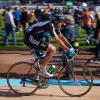





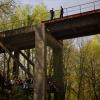
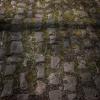






The Benelux cycling (and pedestrian) tunnel was, as I understand it, built as an access tunnel but also to do double duty when not needed for...
Maybe it is the latest ruse for insurers to avoid payouts saying "You didn't tell us that you took the key out of the lock so we're refusing your...
That idea has gone out of the window. The new idea is that if you see a cyclist you honk your horn and watch what happens. It ended very badly in...
I'm still running an ELMNT BOLT V1, and I've never really understood the LED's. I'm sure I configured them for HR zones, but never really look at...
Mostly agree. Although ... high level sport is complicated. It's not wrestling exactly, but there sometimes seems to be more than a little...
It just seems a lot of trouble to go, doesn't it. If you are into building stuff like this perhaps some system where the vehicle brings you to...
Why is this not the will of god?
PKD foresaw it, though his novel was based on a different outcome of WWII, not the precursor to WWIII. Maybe the Idiocracy film is a closer fit?
@Sredlums: I'm not sure I follow your logic. If someone grabs your helmet twists it, then the reason it doesn't feel good is because the outer is...
Coming to the mid-paced Saturday club ride soon.